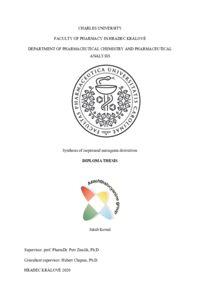Synthesis of isoprenoid naringenin derivatives
Syntéza isoprenoidních derivátů naringeninu
diplomová práce (OBHÁJENO)

Zobrazit/
Trvalý odkaz
http://hdl.handle.net/20.500.11956/121054Identifikátory
SIS: 205475
Katalog UK: 990023833140106986
Kolekce
- Kvalifikační práce [6957]
Autor
Vedoucí práce
Konzultant práce
Chapuis, Hubert
Oponent práce
Demuth, Jiří
Fakulta / součást
Farmaceutická fakulta v Hradci Králové
Obor
Farmacie
Katedra / ústav / klinika
Katedra farmaceutické chemie a farmaceutické analýzy
Datum obhajoby
15. 9. 2020
Nakladatel
Univerzita Karlova, Farmaceutická fakulta v Hradci KrálovéJazyk
Angličtina
Známka
Výborně
4 Abstrakt Univerzita Karlova, Farmaceutická fakulta v Hradci Králové Katedra Katedra farmaceutické chemie a farmaceutické analýzy Kandidát Jakub Kernal Konzultant Hubert Chapuis, Ph.D. Název diplomové práce , intenzivního výzkumu pro své antibakteriální, antimykotické a cytotoxické - v této práci (Fig. 1) cí hydroxylové skupiny flavonoidu v poloze 4 , nebo esterifikací hydroxylových skupin na obou kruzích flavonoidu A -uhlík na kruhu A flavonoidu. Fig. 1. Modifikace molekuly naringeninu esterifikace (modrá) nebo tvroba vazby uhlík-uhlík .
5 Abstract Charles University, Faculty of Pharmacy in Hradec Králové Department Department of Pharmaceutical Chemistry and Pharmaceutical Analysis Candidate Jakub Kernal Supervisor prof. PharmDr. Consultant Hubert Chapuis, Ph.D. Title of Thesis Synthesis of Isoprenoid Naringenin Derivatives Naringenin as a member of flavanone subclass of flavonoids and its derivatives have been subjects of intensive study for their antibacterial, antifungal, and antineoplastic properties. Recent development in current methods of synthetic chemistry allows us to satisfy the increasing demand for these molecules by providing an alternative source of these naturally occurring substances in the means of chemical synthesis. The aim of this work was synthesis and characterization of naringenin derivatives with increased lipophilic profile which will serve in future research as potential cytotoxic agents. Two major approaches have been developed in the process of obtaining lipophilic derivatives of naringenin (Fig. 2) where the lipophilic moiety consists of terpene or terpenoid part, which is believed to increase the uptake of the desired product by cells. In the first approach, we focused on the modification of the B phenolic ring by esterification of the hydroxyl group on the 4 carbon or on the modification of both A and B...
